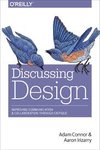
Saved by Daniel Wentsch
Discussing Design

Saved by Daniel Wentsch
Examples of questions you might ask:Can you tell me more about what your objectives were for [specific aspect or element of the design]?What other options did you consider for [aspect/element]?Why did you choose this approach for [aspect/element]?Were there any influencers or constraints that affected your choices?
asking about design objectives
But, what about other aspects of the design? What about other questions that come up? For example:What new problems, complications, or successes might arise from the choices being proposed?What other objectives should the designer have been considering, but didn’t?Raising these kinds of questions can be important. Ignoring them might mean missing
... See moreadditional questions can be important but must be addressed with scope in mind
Where are you in your process?This question reveals a designer’s intended fidelity of thinking. Everyone’s design process is different, and in many cases they vary from project to project. By understanding where a designer feels like he is in his own journey, I can tailor the language in my feedback to reflect that. Is something about to go to a
... See moreKnowing the stage a design that is being reviewed is in, is crucial to give valuable feedback.
Are those elements effective in achieving the objective?Now that we are thinking about specific objectives and the aspects of the design related to them, it’s time to ask whether we think those choices will work to achieve the objective. This is the crux of critical thinking.Why or why not?Finally, we need to think about the result that we think
... See moreThis is your chance to open up the dialogue. By asking questions you give yourself more information on which to base your analysis and give stronger, actionable feedback. If done in a noninterrogative way, it shows the designer that you’re genuinely interested in not only his work, but the thinking behind it, which can make discussing it and
... See moreAsk questions to give better feedback and show genuine interest
What is the objective of the design?We want to understand what we’re analyzing the design against so that we can focus our attention on things that are pertinent to the conversation and the improvement and success of the design. Try to identify the objectives that the designer was aiming to accomplish through the choices she made. What are the
... See moreCentral IdeaGiving good critique is a skill that begins with the right intentions. Help the recipient understand how effective the design is by making sure that you’re avoiding selfish, untimely, incomplete, or preferential feedback and by following best practices.
setting the right intentions for critique
This kind of feedback is not only unhelpful—it does nothing to analyze a design with regard to objectives—but it can also be distracting and counterproductive. This is especially the case when it comes from team members or stakeholders who are in a position of approval. In these situations, the team begins, consciously or subconsciously, to
... See more[about: feedback from purely preferential thinking]
Central IdeaForming critique is a simple four-step process. What are the design’s objectives? What are the elements of the design related to those objectives? Are those elements effective? Why or why not?
4 Steps of Design Critique